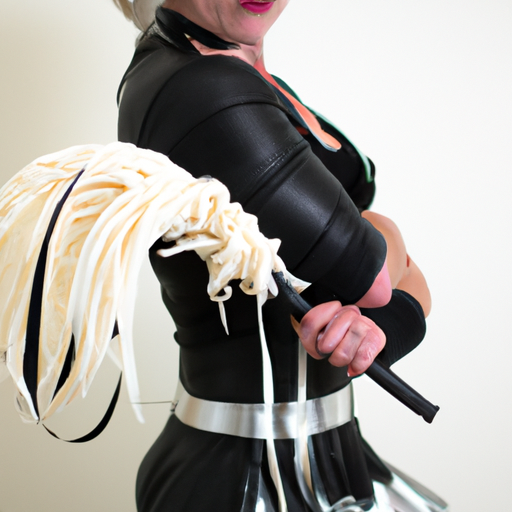In recent years, popular media has seen an increase in diverse representations of sexuality and kinks. One particular area that has garnered attention is the depiction of granny femdom. This unique niche explores the intersection of age and dominance, challenging societal norms and pushing the boundaries of sexual expression. While some may view it as controversial, it is essential to approach this topic with an open mind and a commitment to understanding and respecting diverse preferences.

Granny femdom refers to a subgenre within the broader BDSM community that revolves around older women in positions of power and dominance. It involves scenarios where these ‘grannies’ assert control over their submissive partners, often younger individuals. This dynamic is typically portrayed through various media forms such as books, movies, and adult content websites.
When examining popular media representations of granny femdom, it is crucial to acknowledge that not all depictions are created equal. Some media outlets approach this topic with sensitivity and respect, highlighting the importance of consent, negotiation, and communication within BDSM relationships. These portrayals aim to challenge ageism and celebrate sexual agency among older women.
Books, for example, have been a platform for exploring the complexities of granny femdom. Well-known authors like Anne Rice, in her ‘Sleeping Beauty’ series, and Alison Tyler, in ‘Dark Secret Love,’ have delved into the subject matter. These novels delve into the psychological aspects of the dominant-submissive relationship, providing readers with a deeper understanding of the dynamics at play.
In the film industry, granny femdom has been explored in more niche productions. These films often aim to challenge societal perceptions of beauty and sexuality, promoting body positivity and emphasizing the importance of consent. ‘The Duke of Burgundy,’ directed by Peter Strickland, is a notable example. This arthouse film delves into the intricacies of a relationship between two women, one of whom takes on the dominant role.
Adult content websites have also become a platform for exploring granny femdom. While these platforms often face criticism for the portrayal of older women as fetish objects, some creators strive to break stereotypes and provide a more nuanced representation. These representations emphasize the importance of mutual respect, boundaries, and consent within the BDSM community.
It is essential to critically analyze these media representations and consider their impact on society. On one hand, media that promotes granny femdom can challenge ageism and encourage open conversations about sexuality among older individuals. It can also provide a platform for individuals with similar interests to connect and explore their desires in a safe and consensual manner.
However, it is crucial to ensure that these depictions remain respectful and consensual, avoiding harmful stereotypes or objectification. Media creators must strive to present a balanced portrayal of granny femdom that showcases the complexity of power dynamics within BDSM relationships.
In conclusion, popular media representations of granny femdom offer a unique opportunity to challenge societal norms and explore the complexities of age and dominance. While some media outlets approach this topic with sensitivity and respect, others fall into harmful stereotypes or objectification. It is crucial to critically analyze these representations and engage in open and respectful conversations about diverse sexual preferences. By doing so, we can foster a more inclusive and understanding society that embraces the full spectrum of human sexuality. Published here.
What are some common misconceptions about the dominant role in real African femdom?
African Femdom: Debunking Common Misconceptions

When it comes to the world of dominant-submissive relationships, there are numerous misconceptions and stereotypes that often cloud people’s perceptions. In particular, the dominant role in African femdom is often misunderstood and misrepresented. In this blog post, we aim to shed light on some of the most common misconceptions surrounding the dominant role in real African femdom.
Misconception 1: African Femdom is Only About Physical Domination
One of the most prevalent misconceptions about African femdom is the belief that it solely revolves around physical domination. While physical aspects may be present in some relationships, it is crucial to understand that African femdom encompasses much more than just physical acts. It is about power dynamics, consent, trust, and mutual respect. Emotional and psychological aspects play a significant role in the dynamic, creating a safe and fulfilling space for both the dominant and submissive.
Misconception 2: African Femdom is Inherently Abusive
Another common misconception is that African femdom is synonymous with abuse. This misconception stems from a lack of understanding and the tendency to conflate dominance with cruelty. In reality, African femdom emphasizes the importance of consent, boundaries, and open communication. It is essential to distinguish between healthy dominance and abuse, as any relationship, regardless of its dynamics, can be abusive if consent and respect are absent.
Misconception 3: African Femdom is Oppressive to Women
Contrary to the belief that African femdom perpetuates the oppression of women, it actually challenges traditional gender roles and stereotypes. In real African femdom relationships, women willingly and consensually embrace their dominant roles. It is not about belittling or suppressing men, but rather exploring and celebrating female empowerment and agency. African femdom can be seen as a form of gender equality, where women are encouraged to embrace their desires and assert their dominance.
Misconception 4: African Femdom is a Fetish
While African femdom may be explored within the context of fetishism, it is essential to recognize that it is not solely a fetish. Fetishization tends to objectify and reduce a person to their sexual preferences, which is not the essence of African femdom. It is a lifestyle choice and a consensual power exchange dynamic that goes beyond purely sexual desires. African femdom is about trust, exploration, and self-discovery, encompassing various aspects of one’s identity and relationships.
Misconception 5: African Femdom is a ‘Black-only’ Phenomenon
African femdom is not limited to individuals of African descent, as anyone can engage in this form of power exchange. It is crucial to avoid racializing the dynamics of African femdom and recognize that it is open to people of all backgrounds. By embracing diversity and inclusivity, we can challenge stereotypes and expand our understanding of African femdom as a universal concept that transcends racial boundaries.
In conclusion, it is crucial to debunk the misconceptions surrounding the dominant role in African femdom. African femdom is not solely about physical domination or abuse but rather about power dynamics, consent, and mutual respect. It challenges traditional gender roles and stereotypes, empowering women to embrace their desires and assert their dominance. African femdom is not solely a fetish but a lifestyle choice that goes beyond sexual preferences. Lastly, it is essential to recognize that African femdom is open to people of all backgrounds, promoting diversity and inclusivity within the BDSM community.